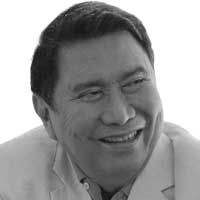Yolanda

Four days ago, on Nov. 8, the country memorialized the disaster that was Super Typhoon Yolanda (international name: Haiyan), the worst natural calamity to hit the country.
I was in Tacloban City three days after Yolanda (Nov. 11, 2013), leading the first non-government entity to arrive at ground zero, modesty aside.
The following is an edited version of an article I wrote in another broadsheet:
I was not prepared for the scenes of suffering that would haunt me for the rest of my life, as we landed at the Tacloban City airport.
I had formed a medical and mercy mission of 12 doctors from St. Luke’s Hospital and six non-medical people, including myself. We landed in the city three days after Super Typhoon Yolanda struck. One doctor had backed out, so we became a 17-member mission.
From the air, the once-bustling city of more than 200,000 people looked desolate. Everything was a total mess. It was as if an atomic bomb had been dropped.
As the Philippine Airlines (PAL) plane prepared to land, I saw people walking aimlessly like zombies.
Dr. Sammy Tanzo, head of the medical side of the mission, decided to have our group stay in the premises of the airport.
We set up a makeshift hospital inside the shell of a one-story building near the airport control tower, joining forces with three military doctors and five medical aides who had come ahead of us.
Patients started pouring in. They came from a line of a jostling crowd three meters thick and half a kilometer long.
The crowd of people, separated from us by a fence guarded by soldiers, were waiting for their numbers to be called so they could board Philippine Air Force (PAF) C-130 cargo planes.
It seemed everybody wanted to fly out of Tacloban.
One of our first patients was an 18-year-old girl. She writhed and shouted in pain as her wounds were sutured.
She had lost both parents as the sea rampaged on land, destroying everything in its path. She survived by clinging to a tree trunk.
After nearly drowning, she escaped from a group of men who, she said, tried to rape her.
Another patient said 15 of her female sales clerks, who were staying at a department store in the city, were raped by looters.
A 4-year-old boy, his head bleeding from a fall, cried as one doctor in my group treated his wound.
When I asked whose child he was, the woman who had taken him to the hospital said he had lost his parents, and she was now taking him to Cebu province with her family.
I saw two children, aged between 5 and 9, separated from their parents as they were taken away to ride a PAF C-130 plane.
The children’s parents shouted to a neighbor lucky enough to be one of 30 civilians taken into the plane to take care of the kids while they jostled with others for the next flight.
Healthy passengers were loaded on the plane at random.
Those very sick and needed to be hospitalized were given priority.
I helped a man with a fractured knee get into a C-130 of the US Air Force with his crying wife on Tuesday. By then, the plane had apparently received orders to take on civilian passengers.
The American crew said they wouldn’t take him aboard if he was not accompanied by a doctor. I asked an elderly doctor in my group to accompany the man and his wife on the plane.
The doctor was just sitting in a corner, staring into space, probably affected by the mayhem.
Another member of my mission became reclusive and didn’t want to give away the food we were distributing to the victims.
I had brought a ton of foodstuff, tents, blankets and bottled water to Tacloban.
An English-speaking couple, whom I judged to be from the upper middle class, came to our tent asking for food and water.
“Mr. Tulfo, we haven’t eaten for days and we’re very thirsty,” the wife, a mestiza, said.
There was no distinction between rich and poor in that disaster; everyone was equal.
Rich and poor alike came begging for food and water. Sometimes, we hid our few bottles of mineral water from them, as we also had to keep some for ourselves.
But we couldn’t eat while people in the crowd looked at us with envy. We had to ration the food we were giving away, as we couldn’t feed the entire multitude.
There were just too many of them.
A few hours after we landed, we ran out of medicines.
As Dr. Tanzo and I prayed that somebody would come to replenish our medicines, a man from Cebu who had landed on a C-130 asked for the whereabouts of people from the DOH and the social welfare department so he could dispose of his load.
Dr. Tanzo and I “hijacked” the medicines and shared them with the military doctors.
On Tuesday, a PAL plane from Manila unloaded doctors with the letters “DOH” emblazoned on their bush jackets.
I begged them for medicines, as we had already exhausted our supply, including the medicines we had hijacked.
They said they had none.
When I asked them what they came to Tacloban for, one said they were “assessing the situation.”
One of our patients died on Tuesday night and was taken out of the hospital on Wednesday, because there was no body bag.
As a body bag was being carried by five men to a truck, the crowd seemed indifferent to the death. In normal times, people would have looked at the relatives with compassion.
I held back my tears as I saw the suffering around me – me, a jaded journalist who had covered the police beat for many years.
- Latest
- Trending


























